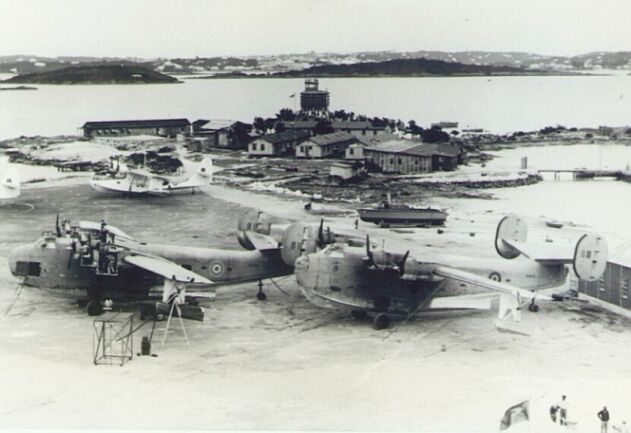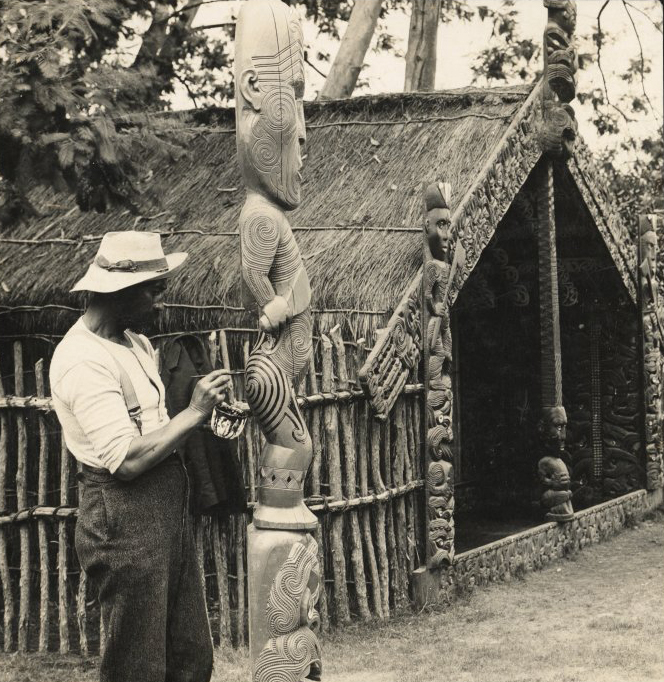|
PB2Y (cocktail)
The PB2Y, or PB2Y Gremlin, is a tiki drink created by Victor Bergeron as part of a series of "gremlin" drinks for his ''Trader Vic's'' restaurants during World War II. Ingredients The ingredients for the cocktail call for 1 1/2 oz of silver rum, 1 1/2 oz of orange juice, 3/4 oz lemon juice, 1/2 oz orange curacao, 1/4 oz lime juice, and 1/4 oz grenadine, along with 3 cups of crushed ice and garnished with a gardenia. Bergeron's 1947 ''Bartender's Guide'' called for the drink to be served in a ceramic "gremlin bowl." History Bergeron served three different sized versions of his Gremlin drinks depending on how many people would be drinking the cocktail. The P-40 Gremlin was for one person, the PB2Y Gremlin served two, and the B-17 Gremlin served four. Life magazine called them "formidable looking potions." The drinks were in general named after the mythological Gremlin creatures that caused mechanical problems for World War II aviators. The PB2Y was a reference to the PB2Y Coronado ... [...More Info...] [...Related Items...] OR: [Wikipedia] [Google] [Baidu] |
Tiki Bar
A tiki bar is a themed drinking establishment that serves elaborate cocktails, especially rum-based mixed drinks such as the Mai Tai and Zombie cocktails. Tiki bars are aesthetically defined by their tiki culture décor which is based upon a romanticized conception of tropical cultures, most commonly Polynesian. Some bars also incorporate general nautical themes or retro elements from the early atomic age. Many early tiki bars were attached to hotels or were the bar sections for large Asian restaurants. While some are free-standing, cocktail-only affairs, many still serve food; and some hotel-related tiki establishments are still in existence. Large tiki bars may also incorporate a stage for live entertainment. Musicians such as Alfred Apaka and Don Ho played a historically important role in their popularity, and also book acts with other exotica-style bands and Polynesian dance floor shows. History Don the Beachcomber One of the earliest and perhaps the first of what is no ... [...More Info...] [...Related Items...] OR: [Wikipedia] [Google] [Baidu] |
Trader Vic's
Trader Vic's is a restaurant and tiki bar chain headquartered in Emeryville, California, United States. Victor Jules Bergeron, Jr. (December 10, 1902 in San Francisco – October 11, 1984 in Hillsborough, California) founded a chain of Polynesian-themed restaurants that bore his nickname, "Trader Vic". He was one of two people who claimed to have invented the Mai Tai. The other was his amicable competitor for many years, Donn Beach of the "Don the Beachcomber" restaurants. History Bergeron attended Heald College in San Francisco. On November 17, 1934, using $500 in borrowed money, Bergeron opened a small bar/restaurant across from his parents' grocery store at San Pablo Avenue and 65th Street in the Golden Gate District of Oakland. He named it Hinky Dink's. As its popularity spread, the menu and decor developed an increasingly tropical flair, and Hinky Dink's soon became Trader Vic's. In 1949, Western Hotels executive Edward Carlson convinced Bergeron to open his first fra ... [...More Info...] [...Related Items...] OR: [Wikipedia] [Google] [Baidu] |
Doubleday (publisher)
Doubleday is an American publishing company. It was founded as the Doubleday & McClure Company in 1897 and was the largest in the United States by 1947. It published the work of mostly U.S. authors under a number of imprints and distributed them through its own stores. In 2009 Doubleday merged with Knopf Publishing Group to form the Knopf Doubleday Publishing Group, which is now part of Penguin Random House. In 2019, the official website presents Doubleday as an imprint, not a publisher. History The firm was founded as Doubleday & McClure Company in 1897 by Frank Nelson Doubleday in partnership with Samuel Sidney McClure. McClure had founded the first U.S. newspaper syndicate in 1884 (McClure Syndicate) and the monthly ''McClure's Magazine'' in 1893. One of their first bestsellers was ''The Day's Work'' by Rudyard Kipling, a short story collection that Macmillan published in Britain late in 1898. Other authors published by the company in its early years include W. Somerset M ... [...More Info...] [...Related Items...] OR: [Wikipedia] [Google] [Baidu] |
Gremlin
A gremlin is a mischievous folkloric creature invented at the beginning of the 20th century to originally explain malfunctions in aircraft and later in other machinery and processes and their operators. Depictions of these creatures vary widely. Stories about them and references to them as the causes of especially inexplicable technical and mental problems of pilots were especially popular during and after World War II.gremlin on gremlin in the American Heritage Dictionary Use of the term in the sense of a mischievous creature that sabotages aircraft ... [...More Info...] [...Related Items...] OR: [Wikipedia] [Google] [Baidu] |
Consolidated PB2Y Coronado
The PB2Y Coronado is a large flying boat patrol bomber designed by Consolidated Aircraft, and used by the US Navy during World War II in bombing, antisubmarine, and transport roles. Obsolete by the end of the war, Coronados were quickly taken out of service. Only one known example remains, at the National Naval Aviation Museum at Naval Air Station Pensacola, Florida. Design and development After deliveries of the PBY Catalina, also a Consolidated aircraft, began in 1935, the United States Navy began planning for the next generation of patrol bombers. Orders for two prototypes, the XPB2Y-1 and the Sikorsky XPBS-1, were placed in 1936; the prototype Coronado first flew in December 1937. After trials with the XPB2Y-1 prototype revealed some stability issues, the design was finalized as the PB2Y-2, with a large cantilever wing, twin tail with very marked dihedral, and four Pratt & Whitney R-1830 radial engines. The two inner engines were fitted with four-bladed reversible pitch p ... [...More Info...] [...Related Items...] OR: [Wikipedia] [Google] [Baidu] |
Donn Beach
Donn Beach (born Ernest Raymond Gantt; February 22, 1907 – June 7, 1989) was an American adventurer, businessman, and World War II veteran who was the "founding father" of tiki culture. He is known for opening the first prototypical tiki bar, Don the Beachcomber, during the 1930s in Hollywood, California, which was expanded to a chain of dozens of restaurants throughout the United States. He later built the International Market Place and additional establishments in what was then the Territory of Hawaii. He married three times. Early life Gantt was born in 1907, with some sources indicating he was born in New Orleans and growing up in Limestone County, Texas and others indicating that he was born in Texas. A U.S. Census document from 1910 has him living in Limestone County, Texas at the age of 3. The same 1910 census document lists him as being born in Texas, and his mother, Molly Gant, as having a father who was born in Louisiana. In a 1987 interview for The ''Watumull Foundation ... [...More Info...] [...Related Items...] OR: [Wikipedia] [Google] [Baidu] |
Martin B-26 Marauder
The Martin B-26 Marauder is an American twin-engined medium bomber that saw extensive service during World War II. The B-26 was built at two locations: Baltimore, Maryland, and Omaha, Nebraska, by the Glenn L. Martin Company. First used in the Pacific Theater of World War II in early 1942, it was also used in the Mediterranean Theater and in Western Europe. After entering service with the United States Army aviation units, the aircraft quickly received the reputation of a " widowmaker" due to the early models' high accident rate during takeoffs and landings. This was because the Marauder had to be flown at precise airspeeds, particularly on final runway approach or when one engine was out. The unusually high 150 mph (241 km/h) speed on short final runway approach was intimidating to many pilots who were used to much slower approach speeds, and when they slowed to speeds below those stipulated in the manual the aircraft would often stall and crash.Ethell 1995, p. 24 ... [...More Info...] [...Related Items...] OR: [Wikipedia] [Google] [Baidu] |
Scorpion Bowl
A Scorpion Bowl is a communally shared alcoholic tiki drink served in a large ceramic bowl traditionally decorated with wahine or hula-girl island scenes and meant to be drunk through long straws. Bowl shapes and decorations can vary considerably. Starting off as a single-serve drink known as the Scorpion cocktail, its immense popularity as a bowl drink in tiki culture is attributed to Trader Vic. The drink contains light rum, brandy, and orgeat syrup along with orange and lemon juice and is typically heavily garnished. The ceramic vessel itself is also referred to as a "scorpion bowl". Different versions can have multiple types of rum (overproof, dark and white), gin, wine, and fruit juices. If a sparkling wine "floater" is being added this should be done last after the other ingredients have been mixed. Trader Vic Scorpions Trader Vic is largely credited with inventing the Scorpion Bowl, which after the Mai Tai and the Fog Cutter was Vic's third most famous cocktail. As cal ... [...More Info...] [...Related Items...] OR: [Wikipedia] [Google] [Baidu] |
Tiki Drinks
In Māori mythology, Tiki is the List of protoplasts, first man created by either Tūmatauenga or Tāne. He found the first woman, Marikoriko, in a pond; she seduced him and he became the father of Hine-kau-ataata. By extension, a tiki is a large or small wooden, pounamu or stone carving in humanoid form, notably worn on the neck as a hei-tiki, although this is a somewhat archaic usage in the Māori language. Hei-tiki are often considered taonga, especially if they are older and have been passed down throughout multiple generations. Carvings similar to ngā tiki and coming to represent Ancestor worship, deified ancestors are found in most Polynesian cultures. They often serve to mark the boundaries of sacred or significant sites. In the Western world, Tiki culture, a movement inspired by various Pacific cultures, has become popular in the 20th and 21st centuries; this has proven controversial, however, as the movement is regarded by many Polynesians as cultural appropriation. Re ... [...More Info...] [...Related Items...] OR: [Wikipedia] [Google] [Baidu] |
Cocktails With Rum
A cocktail is a mixed drink typically made with a distilled liquor (such as arrack, brandy, cachaça, gin, rum, tequila, vodka, or whiskey) as its base ingredient that is then mixed with other ingredients or garnishments. Sweetened liqueurs, wine, or beer may also serve as the base or be added. If beer is one of the ingredients, the drink is called a beer cocktail. Cocktails often also contain one or more types of juice, fruit, honey, milk or cream, spices, or other flavorings. Cocktails may vary in their ingredients from bartender to bartender, and from region to region. Two creations may have the same name but taste very different because of differences in how the drinks are prepared. This article is organized by the primary type of alcohol (by volume) contained in the beverage. Cocktails marked with "IBA" are designated as IBA official cocktails by the International Bartenders Association, and are some of the most popular cocktails worldwide. Absinthe * Death in the Af ... [...More Info...] [...Related Items...] OR: [Wikipedia] [Google] [Baidu] |
.jpg)
_(12001586684).jpg)

_(12001506164).jpg)


